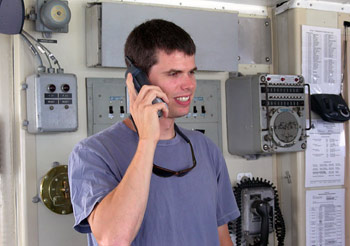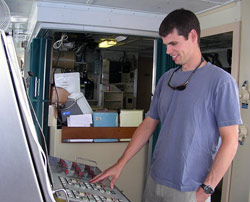Interview with Adam Seamans

Where did you grow up and how did you get interested in boats?
I grew up in Beverly, Mass., and as a toddler, my father used to take me sailing in the afternoons—I suspect, to give my mother a break! I learned to sail when I was about 7 years old. I grew up on sailboats and have always loved being on the water.
How did you get the qualifications necessary to become a deck officer?
I attended Maine Maritime Academy and went into the licensed deck program. This meant that I was studying for a B.S. degree, as well as working towards a Third Mate’s license. Part of the training included time at sea, not only on the Academy’s training ship, but also spending a summer on a commercial ship. I ended up on a 188,000-ton Alaskan crude oil tanker. I graduated in 2000 with a B.S. degree in Marine Transportation/ Nautical Science and a Third Mate’s license.
What did you do after you graduated?
I got a job as a Third Mate on a chemical tanker. But I had also applied for a position on one of the WHOI ships. I knew about Woods Hole Oceanographic Institution for three reasons. As a kid, I had been to Martha’s Vineyard a number of times (an island off the coast of Cape Cod where Woods Hole village is located). While catching the ferry to the Vineyard, I was always interested in the SEA (Sea Education Association) sailing research vessels and the WHOI vessels tied up to the dock. Second, I was fascinated when scientists aboard the Knorr located the Titanic in 1985 (It was a joint French-American effort). And third, my grandfather was very involved in both WHOI and SEA, so I had heard him talk about both organizations.
Anyway, a few months after I started work on the chemical tanker, I was offered a position on R/V Knorr, and have worked my way up to be Chief Mate. I have also sailed on R/V Atlantis.
What does your job entail?
I spend 6-8 months a year at sea. Apart from standing an 8-hour watch (on this ship, broken up into a 6-hour watch and a 2-hour watch), I have a number of other responsibilities. I am Officer of the deck—so I am in charge of deck maintenance, and working with the bosun to ensure maintenance gets done and standards are met. I also am involved in all cruise preparation, science operations, and coordination so that the mission of the scientists is accomplished.
The Chief Mate is also second in command to the Captain. In an emergency, I am ‘scene leader’ for the fire party and direct the launching of the starboard life rafts if we were to abandon ship. The Chief Mate is also the person responsible for all safety equipment on the ship—I work with the Third Mate in the area of safety, and she is responsible for maintaining all the safety equipment. The Second Mate is responsible for navigation and the ship’s schedule.
Most recently, security has been added to my list of tasks. I am responsible for ensuring all security procedures are followed at sea and, more importantly, when we go into ports.
 What are the rewards and hardships of your job?
I really enjoy the responsibilities and challenges of the job and, when things go well, I find it very rewarding. Although I like sailing on commercial ships, there are some aspects of working on a research vessel that are appealing to me. I like being involved in scientific research, which can produce interesting challenges for ship operations. I also get more opportunities to maneuver the ship (rather than going directly from port to port), and even though much of the machinery is smaller than on a commercial vessel, it is equally, if not more, important. I also like the opportunity afforded by research vessels to visit northern climates, such as the waters off Greenland, Iceland, and Norway—something not possible on commercial vessels that ply the commonly traveled shipping lanes and go into the larger ports. Finally, having 2-3 months off a year allows me to do other things.
In terms of hardships, I would say the biggest challenge is knowing that, when you leave home, the situation there continues to move on, so that when you come back, things have changed. This hardship on your social situation is probably the most universal issue for shipboard crew members. I am also a homeowner—I have a cabin in Maine—so I have the worries that go along with that.
What sorts of things do you do in the time you are not on the ship?
I still sail the boat that my father used to take me out on when I was a kid. I am also learning to windsurf, and I have found that I enjoy hiking (much to my surprise)! In winter, I like to go to my cabin in Maine and go skiing.
And the future for you?
I am planning to move up and hopefully get my Master’s license. When I go home in February, I will submit my time for my Master’s license. I’ve completed all the necessary requirements and passed the test.
I am engaged to be married this year, so I don’t yet know how that will affect my plans for the future.
What advice would you give a student interested in becoming a Deck Officer?
First you must be interested in working with other people. Before committing to a career at sea, perhaps go out as a crew member, such as a mess attendant, and see if you enjoy it. To do that requires some training in safety, firefighting, etc., but may well be worth it to find out what life at sea is like. Becoming a Deck Officer requires a lot of time, as well as a lot of time away from home, so you really need to look deeply inside yourself to see if this is a career for you. If you decide it is, then you will likely find it very enjoyable and rewarding.
[Back
to top]
|





